Uttarakhand’s 1st Glass Bridge in Rishikesh and New Opening date
“Where Lord Lakshman once crossed the river with the help of ropes, now the country’s first glass bridge in Rishikesh is being built”
Old Laxman Jhula Rishikesh
Laxman Jhula in Rishikesh, Uttarakhand, is one of the best places to visit. Here, you will find both religious sites as well as adventure activities to enjoy. If you visit Rishikesh, you will come across Laxman Jhulaa and Ram Jhula. It connects Tapovan in Tehri Garhwal district with Jonk in Pauri Garhwal district. Laxman Jhula has a special association with Lord Lakshman.
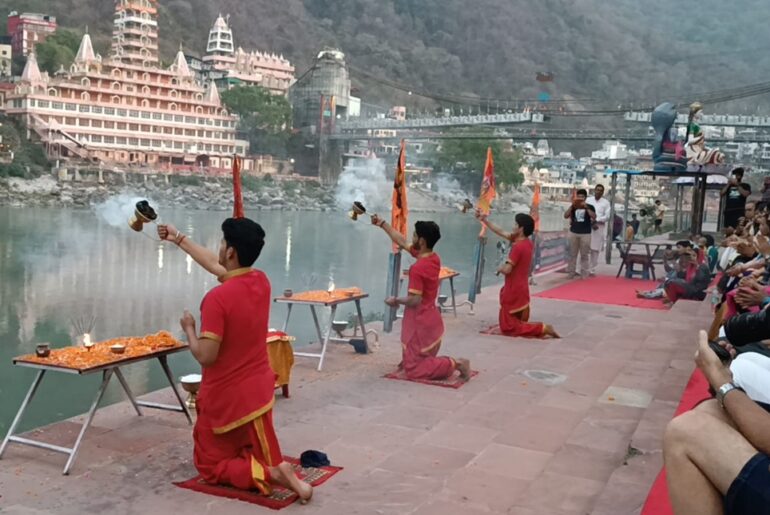
New Laxman Jhula Rishikesh
In Rishikesh, near the world-famous Lakshman Jhula, the construction of a glass bridge in Rishikesh (Bajrang Setu) is in progress. The construction company claims that the glass bridge will be ready by 31 Oct 2025.
So far, 85% of the work has been completed. People are excited because soon, there will be no need to visit China to see a glass bridge. They can enjoy it right in Rishikesh!
The Bajrang Setu will be 132.3 meters long and 8 meters wide. Both sides of the bridge will have glass walkways where people can walk. Everyone is eagerly waiting for the bridge to be completed.

Bajrang Setu Rishikesh
The Bridge connect Tapovan and Swargashram
The suspension bridge between Tapovan and Swargashram was supposed to be built in 1.5 years, but it is still unfinished after nearly 3 years.
The construction company was supposed to finish the work by July 4, 2023, but they missed the deadline. The PWD gave the company an extension of 12 more months, and the bridge is now expected to be ready by Oct 2025.
On October 27, 2021, the Central Government approved Rs 56 crore under the Central Road and Infrastructure Fund.
This amount was given to the Public Works Department (PWD) to build the Bajrang Setu (glass bridge) between Tapovan and Swargashram. The Narendranagar division of PWD called for tenders and hired a construction company on January 5, 2022, to carry out the project.
Suggested Read: Discover Top 15 Offbeat Things to do in Rishikesh, India

Rishikesh Uttarakhand
Rishikesh, a city in Uttarakhand, is famous as the Yoga City. It is on the banks of the holy river Ganga. This city is the start of Devi Bhoomi. People from all over the world visit here.
Many visitors go to see the old Lakshman Jhula over the Ganga. But this bridge has been closed for a long time. Now, people can enjoy the view of Rishikesh from Ram Jhula.
The 100-year-old Lakshman Jhula is under repair. For safety reasons, it will not open again for use. But there is good news! Uttarakhand‘s first glass bridge in Rishikesh will soon replace it. Let’s talk about this new bridge!
The Uttarakhand government is building a new bridge in Rishikesh called Bajrang Setu. This bridge will replace the old Laxman Jhula.

First glass bridge in Rishikesh
The Bajrang Setu will be India’s first glass bridge in Rishikesh. It will give a thrilling experience to visitors. An official from the Public Works Department said the bridge will be ready by June 2025.
The foundation work is happening on both sides of the Ganga River. The towers on this bridge are being designed to look like the shape of Kedarnath Temple, which makes it even more special!
The Bajrang Setu will be an impressive bridge. The towers will be 27 meters tall, and the bridge itself will be 133 meters long and 8 meters wide.
The bridge will have three lanes. Small two-wheelers can pass through the middle lane. The middle lane will have two 2.5-meter-wide lanes for two-wheelers.
On both sides of the bridge, there will be a glass walkway. Tourists can stand there and enjoy the stunning view of the Ganga River from a height of 57 meters.
Bajrang Setu will be 65 mm thick, making it very strong and safe. The total cost to build this bridge is Rs 68 crore.
Did you know? The old Laxman Jhula Bridge, which this new bridge will replace, was built during British rule between 1927 and 1929.

Rishikesh: The City of Yoga
Rishikesh in Uttarakhand… one of everyone’s favorite places. Known as the land of yoga, Rishikesh tops the list of tourist destinations in Uttarakhand. In Rishikesh, you will find many adventure activities to enjoy, and for devotees of God, it is the best place to visit.
There are many famous temples in Rishikesh. But among all these, what is most popular in Rishikesh are the Lakshman Jhula and Ram Jhula.
These two bridges connect the two banks of Rishikesh. One is called Lakshman Jhula, and the other is Ram Jhula. Tourists use these bridges to cross from one side to the other.
You might think these bridges are just ordinary ones, but their uniqueness and history will change that thought. At present, Lakshman Jhula has been closed.
Closure of Lakshman Jhula and Construction of a Glass Bridge in Rishikesh
Due to cracks in the bridge and weakening of its supporting ropes, Lakshman Jhula has been closed for now, and in its place a new glass bridge is being built. This will be India’s first glass bridge, named Bajrang Setu.
The new bridge is being equipped with modern technology, but the history of the old Lakshman Jhula goes back a long way. Let’s learn about its history and construction.
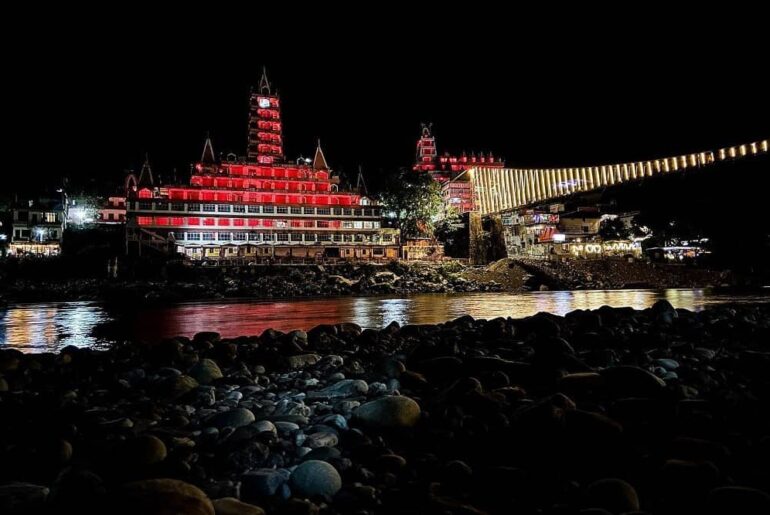
When was the Laxman Jhula bridge built?
Although the 94-year-old Lakshman Jhula has now been closed for public use, its past is very significant. This suspension bridge was constructed during the British era.
Foundation laid: 1923, under the British Government.
Flood setback: In 1924, heavy floods damaged the foundation.
Foundation re-laid: 1927.
Completion: 1929.
Public opening: April 11, 1930.
Interestingly, the original bridge was made of jute ropes, and later it was strengthened with concrete and iron cables.
Officials involved in construction:
Chief Engineer – P. H. Tillard
Superintending Engineer – E. H. Cornelius
Executive Engineer – C. F. Hunter
Assistant Engineers – Jagdish Prasad, Avadh Narain
Overseer – Bala Ram
Why is it called Laxman Jhula?
The bridge connects Tapovan (Tehri Garhwal district) with Jonk (Pauri Garhwal district). The name instantly reminds one of Lord Lakshman, younger brother of Lord Ram.
According to mythology, it is believed that Lakshman once crossed the Ganga at this exact spot using only two ropes. Later, to replace this rope crossing, a suspension bridge was constructed here, which came to be known as Lakshman Jhula.
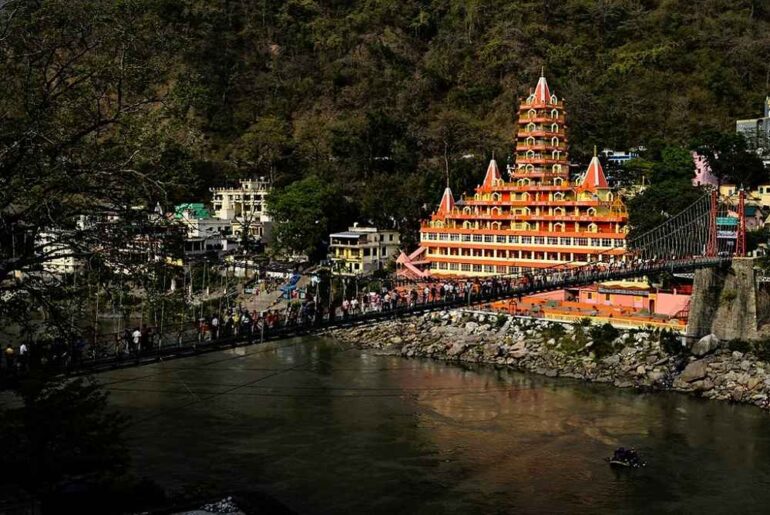
Journey from Jute to Glass Bridge in Rishikesh
Lakshman Jhula always served as a vital link between the two riverbanks of Rishikesh. It was not only useful for locals but also a great attraction for tourists.
Initially, it was made from jute ropes, then replaced with iron cables, becoming the iconic 450-feet-long suspension bridge over the Ganga. Standing on it, one could witness the gushing river flowing across great distances.
Now, in place of this historic suspension bridge, a modern glass bridge—Bajrang Setu—is being built. Equipped with advanced engineering technology, the new structure is set to be even more attractive and iconic.

Currently Closed, Causing Inconvenience to People
For many years, Lakshman Jhula remained open to the public. It was especially important for those traveling between the two riverbanks and also made sightseeing in Rishikesh convenient.
Tapovan, the place where Lakshman Jhula and Ram Jhula are located, is a popular spot with markets and the famous Trayambakeshwar Temple. Tourists usually book hotels in Tapovan as it makes exploring the city easier. Lakshman Jhula is the nearest bridge here, while Ram Jhula is about two kilometers away.
On 3 April 2022, Lakshman Jhula was completely closed for public use. In its place, the construction of India’s first glass bridge is progressing rapidly.
But its closure has caused difficulty for people—especially those wanting to reach Triveni Ghat for the Ganga Aarti. At present, boats are being used to cross the river, charging around ₹40 per person. Locals and tourists alike are eagerly waiting for the completion of the new bridge.
How to Reach Bajrang Setu Glass Bridge in Rishikesh
- By Train: The nearest railway station is Rishikesh Railway Station, about 4 km from Adarsh Nagar.
- By Air: The nearest airport is Jolly Grant Airport in Dehradun, around 22 km from Lakshman Jhula. From there, you can take a local bus or hire an auto-rickshaw to reach the site.
- By Bus: If you arrive by bus, you’ll be dropped at Nepali Farm Flyover. From there:
- Shared auto-rickshaw: ₹50–100
- Private Auto-Rickshaw: ₹700–800
Glass Bridge in Rishikesh Glass Bridge in Rishikesh Glass Bridge in Rishikesh Glass Bridge in Rishikesh
glass bridge in Rishikesh glass bridge in Rishikesh glass bridge in Rishikesh glass bridge in Rishikesh
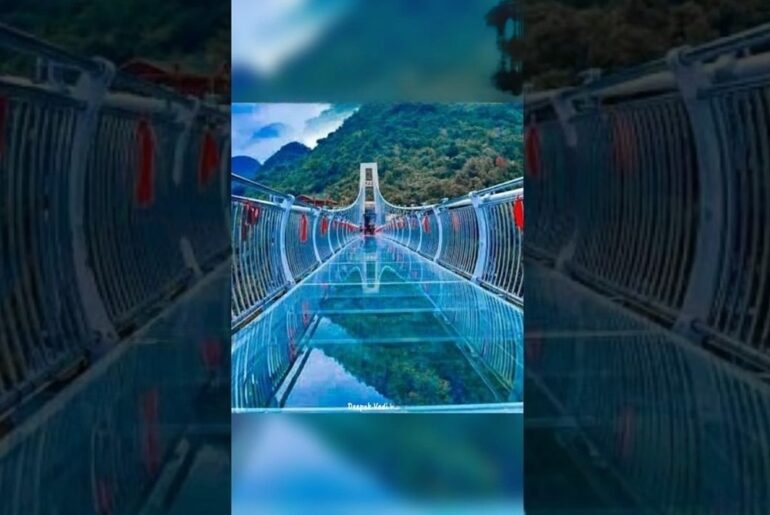

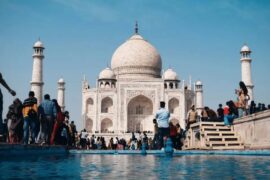

Comments are closed.